#planocraniidae
Explore tagged Tumblr posts
Text

Duerosuchus is a rather small crocodilian from the Eocene of Spain. When initially described it was placed closely to the clade Brevirostres (Gators and Crocs), but a later phylogenetic analysis found out that it was actually a member of the Planocraniidae.
Planocraniidae is a family of terrestrial crocodilians (or more basal Eusuchians) that lived in Eurasia and America during the Paleocene and Eocene. The family also includes the much larger Boverisuchus magniforns from Germany and Boverisuchus vorax from America, as well as Planocrania from China. Effectively speaking, Boverisuchus is the animal previously known as Pristichampsus, because Pristichampsus was based on fragmentary material that wasn't diagnostic enough. So out with the old, in with the new.
Planocraniids were one of multiple groups of crocodiles inhabiting the Eocene rainforests, adapted to a more running lifestyle with toes tipped by hooves and later ziphodont (compressed and serrated) teeth. At least in Boverisuchus. The teeth of Duerosuchus and Planocrania were already flattened, but not serrated. The other three prominent croc groups in the Eocene jungles of the northern hemisphere were crocodiles, represented by "Asiatosuchus" in Spain, alligatoroids, present with Diplocynodon, and Sebecids, a group thats much more ancient and not part of the crown group of crocodiles. Sebecids are present with Iberosuchus, another terrestrial hunter, but one that was much larger than Duerosuchus. (bottom image by Ortega et al.)
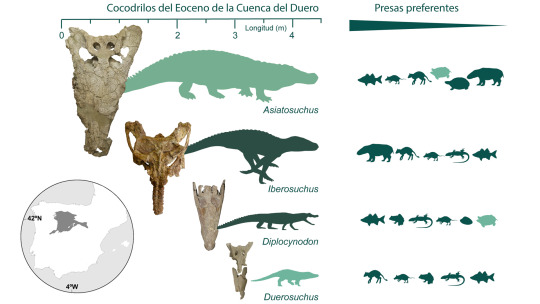
#duerosuchus#planocraniidae#boverisuchus#planocrania#pristichampsus#eocene#paleontology#palaeoblr#spain#duero basin#skeletal reconstruction#steven irwin for scale#crocodiles#prehistory
108 notes
·
View notes
Text
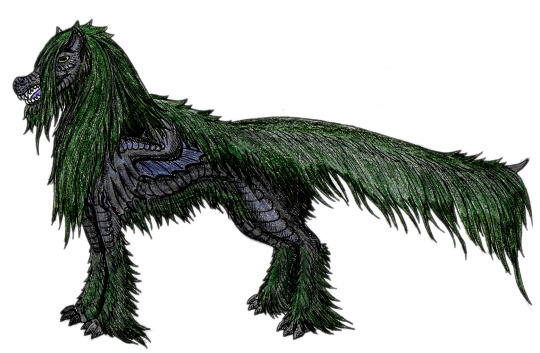
In Scottish Folklore the Kelpie is a shapeshifting water monster that appears to be a Horse on Land that entices people to try to ride on it, but once they get on the Kelpie it's thick weedy mane will wrap around the rider and refuse to let go as the Kelp charges headlong to the nearest body of water to drown the rider! Sounds a lot like how Crocodiles hunt, grabbing creatures who wander too close to the water's edge and then dragging them down to a watery grave. I don't know why I didn't thinks of this sooner! Did you know there is a prehistoric family of crocodilians called Planocraniidae that had hoof-like claws and was thought to gallop like a horse! Sounds a lot like a Kelpie huh...I also love the idea that you could look at it from a distance and think "Is that a horse" Then it turns around and it has a Crocodile face! HA! In Soaring I imagine this is a Nocturnal creature. It spends the day in the water mostly sleeping and then comes up on land at night where it hides among foliage for prey, will charge them down when they don't expect, and then return to the water.
#my art#art#fantasy#dragon#soaring#Soaring Creature#Creature#mythical creatures#Kelpie#Scottish#mythology#Folklore#Horse#Crocodile#crocodilian#prehistoric#prehistoric creature#prehistoric crocodile#Hoofed crocodile
7 notes
·
View notes
Text
Caimulch: The Substrate Pokemon, grass/dark, first stage, a long-legged, crocodilian pokemon similar to Planocraniidae, body is black with white spotting, legs, head, and tail are a mottled brown, twigs grow from around it’s mouth like whiskers, “Blending into the forest floor, Caimulch uses it’s twigs to lure in prey. They’re a popular pet throughout the region.” “If Caimulch fails to catch prey on the first strike, it runs it down relentlessly with their long legs.”, female only, evolves at lvl 30 (commonly seen as a pet around the region, overworld Caimulch have black cords with everstones around their necks)
Fungylus: The Substrate Pokemon, grass/dark, final stage, a large, immobile crocodile pokemon in a mottled brown, back is hidden under a blanket of white and orange mushrooms of various sizes, twig whiskers have been replaced with a full lichen beard, a broken black cord rests around its neck, “Upon evolving mushrooms waiting in Caimulch’s back sprouted. The weight of them prevents Fungylus from moving.” “Though the weight of the mushrooms on it’s back prevent Fungylus from moving, they provide ample camouflage and bait to lure in prey. Their spores will become part of Fungylus’s offspring.”, female only, overworld hazard
0 notes
Text
A Week in Croc News: A ziphodont crocodilian from New Guinea and a "baby" Piscogavialis
Once again I'm here to recap exciting fossil croc news. To give a quick rundown of papers from the last week, we had one on non-semi aquatic adaptations in crocodylomorphs (mostly life on land but also notes of marine groups), a paper that I'm biased toward because it feaures two of my silhouettes in its phylogeny.
The two silhouettes of mine used in the study. Duerosuchus representing the Planocraniidae and Trilophosuchus representing Atoposaurids (eventhough it's not one, it was picked since it at least conveys the right proportions).


Thalattosuchians recieved a lot of attention this past week. For starters, in addition to being brought up in the afforementioned paper, they were given a lot more focus in a study comparing the function and phylogenetic importance of their shoulder girdles (and those of dyrosaurids), a metriorhynchoid skeleton of uncertain affinities from the Cretaceous northeast Italy was described and just today we got a study on the braincase anatomy of Thalattosuchus.
The one paper that excited me the most however was the description of ziphodont crocodilian teeth from the Pliocene Otibanda Formation of Papua New Guinea. To those unaware, ziphodont teeth are essentially teeth that are flattened like a blade and bear serrations along their cutting edge, something seen in dinosaurs, monitor lizards and a select few crocodile groups like sebecid notosuchians, planocraniids and some mekosuchines. Now these teeth are nothing new, they've been known since 1967, hell I even mentioned them on both the wikipedia pages for Mekosuchinae and Quinkana, but they were never properly described...until now.
Leave it to Jorgo Ristevski, Ralph Molnar and Adam Yates to tackle this one, describing not just the ziphodont teeth but also the postcranial material and conical teeth from the formation. Now don't expect any new species or genera. Though valuable, the study doesn't cause any major stirr ups. The ziphodont teeth are tentatively referred to the Mekosuchinae, though they are not morphologically distinguishable from other ziphodont groups like sebecids or the previously mentioned planocraniids, mekosuchines are the only ones that fit the time and location. The other fossils are even more ambiguous, the postcrania referred to Crocodylia incerta sedis and the conical teeth to cf. Crocodylus sp., so basically an unknown crocodilian and a modern croc. This at least suggests that two different crocodiles inhabited Papua New Guinea at the time, maybe even three assuming that the postcrania don't belong to either the ziphodont or conical form.
Since New Guinea and Australia were once connected, forming the continent of Sahul, some Quinkana-like mekosuchines could have easily traveled to the island.


The final thing I want to mention is not an actual study, but still newsworthy. Scientists in Peru just revealed whats thought to be the first juvenile Piscogavialis. An amazingly preserved skeleton was unveiled, preserving much of the skull minus the tip of the snout, most of the spinal collumn until the base of the tail, both hindlimbs and some other bones as well (from the photos theres a few ribs at least).
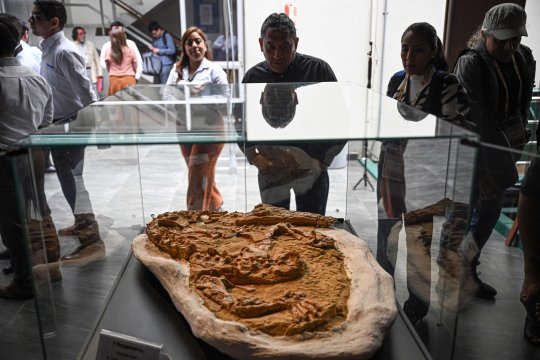
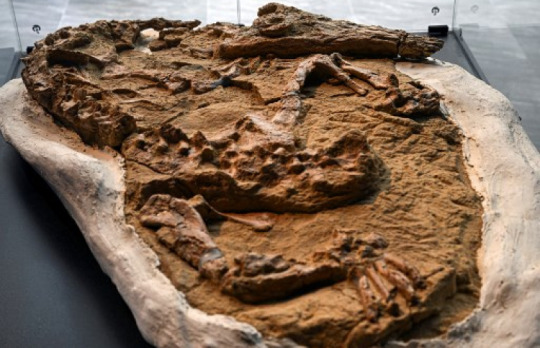
Whats fun is that though described as a juvenile, the animal is estimated to have already reached around 3 meters in length. To put this into perspective, thats the size of the average female saltwater crocodile and just shy of the 4.3 meters reached by the contemporary Sacacosuchus. Now on the one hand, I think calling that a juvenile might be a bit of an exaggeration (then again the term subadult is arguably vague and meaningless) and I'm curious to see whether or not an eventual study will back this up with anatomical features or if its even possible that it could just be an instance of dimorphism between sexes. But thats just me musing on the basis of a few photos.
Anyways, given that they just state that this 3 meter animal is a "juvenile", you might wonder how large the adult would be?
The short answer...large. Yeah Piscogavialis got big. The skull alone measures over a meter in length and a recent paper on Sacacosuchus said that they grow to nearly twice the length of their smaller contemporary. With Sacaco sitting at 4.3 meters, one could easily imagine Piscogavialis reaching 7 to maybe 8 meters (I should make a proper scaling at some point). Here's how Gabriel Ugueto and artbyjrc scaled this animal and yeah, even if it ate fish it could probably do some real damage if provoked.
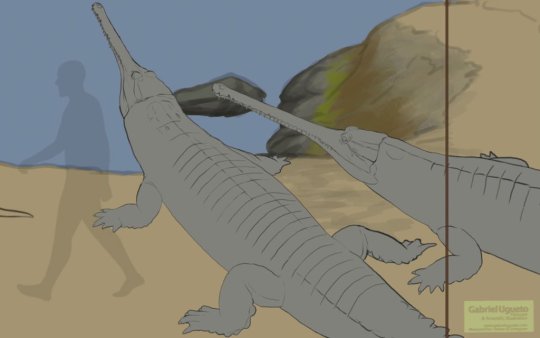

#long post#cenozoic#mesozoic#crocodylia#croc#crocodile#gharial#mekosuchinae#prehistory#palaeblr#extinct#piscogavialis#paleontology news#pseudosuchia#crocodylomorpha
25 notes
·
View notes
Text
Two-stage grass/dark crocodile pokemon. Starts as a little thing, a long-legged crocodilian pokemon similar to member of Planocraniidae. I’m thinking it has a color pattern that makes it look like a busted open bag of mulch. Maybe a main body in a green or black with a head, tail, and legs of mottled brown. Throw in some white spots on the ‘bag’ as well. Along it’s mouth it has whiskers that look like leafy twigs clenched in it’s jaws, which it uses to lure in prey before chasing it down. The grown form is more blatantly a nile or saltwater crocodile. All brown and looking like a rotting log, this stage is completely immobile, having been overgrown by those earlier mentioned white spots, which it turns out were the start of a colony of mushrooms. It’s whiskers have been replaced by a long beard of lichen and moss. Around it’s neck- a black, busted cord. It can’t get up and hunt anymore, but thankfully the mushrooms and it’s coloration give it excellent camouflage, allowing it to quickly snap up anything that unwittingly wanders too close.
The grown form is a hazard encountered in certain forests around the region, sort’ve a new equivalent to Foongus and Voltorb, while you’ll see the base state kept as pets in communities throughout the non-desert & -tundra areas of the region. Because the final form is no fun for kids, and can be very dangerous due to it’s massive appetite, their owners keep them small with Everstones held on black cords around their necks.......
0 notes